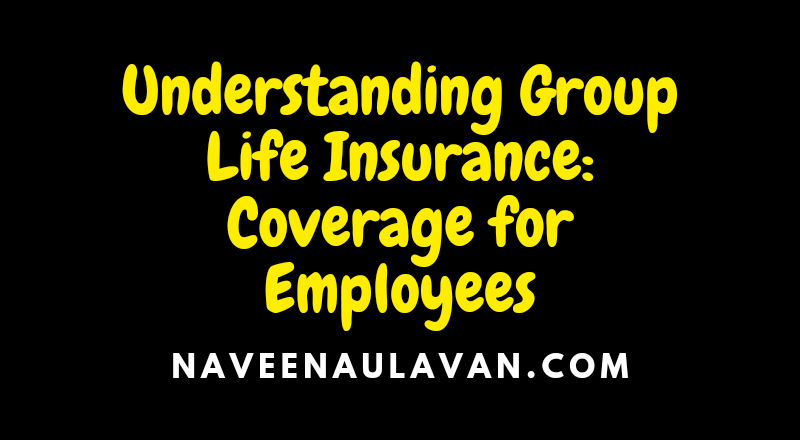Group life insurance is a type of life insurance that provides coverage to a group of people typically employees of a company or members of an organization. It is an excellent employee benefit that helps protect the financial well-being of employees and their families in the event of an untimely death. In this article we will delve deeper into the concept of group life insurance how it works its benefits and considerations for both employers and employees.
How Group Life Insurance Works
Group life insurance works by pooling the risk of a group of individuals. The employer or the organization offering the coverage purchases the insurance policy and pays the premiums. The coverage is then extended to all eligible employees or members of the group automatically without any individual underwriting. Unlike individual life insurance group life insurance does not require medical underwriting or exam making it a convenient option for employees to obtain coverage.
Benefits of Group Life Insurance for Employees
Group life insurance provides several benefits to employees including:
Financial Protection for Dependents
One of the primary benefits of group life insurance is the financial protection it provides to employees’ dependents in the event of their death. If an employee covered under a group life insurance policy passes away the designated beneficiaries will receive a death benefit. This benefit can help replace the lost income and cover various financial obligations such as mortgage payments education expenses and daily living costs.
No Medical Underwriting
Unlike individual life insurance policies group life insurance does not require employees to undergo medical underwriting or exams. This means that individuals with pre-existing health conditions or higher risk profiles can still obtain coverage. The absence of medical underwriting makes group life insurance more accessible and affordable for employees.
Lower Premiums
Group life insurance usually comes at a lower premium than individual life insurance. Since the risk is spread over a larger group the cost per person is reduced. The employer or organization typically pays the majority or all of the premiums making group life insurance an attractive employee benefit.
Portability and Conversion Options
Many group life insurance policies offer portability and conversion options. Portability allows employees to keep their coverage even if they leave their current job. Conversion options enable employees to convert their group policy into an individual policy without the need for additional underwriting. These options provide flexibility and continuity of coverage for employees regardless of their employment status.
Supplemental Coverage
Group life insurance often allows employees to purchase additional coverage for themselves and their dependents through a supplemental plan. This enables employees to tailor their coverage to their specific needs and increase the amount of life insurance protection they have.
Considerations for Employers
Employers offering group life insurance coverage need to consider several factors:
Coverage Amount
Employers must determine the appropriate coverage amount based on the needs of their employees and their dependents. This involves considering factors such as average income family size and financial obligations. Offering an adequate coverage amount ensures that employees’ beneficiaries receive sufficient financial support in the event of a death.
Eligibility and Participation Requirements
Employers must establish eligibility criteria for employees to participate in the group life insurance plan. Common requirements include minimum hours worked per week or length of employment. Clear eligibility guidelines help ensure fairness and consistency within the organization.
Cost Sharing
While employers typically bear most or all of the premium costs for group life insurance they may choose to share the cost with employees. Cost sharing can be done through payroll deductions or other means. Employers should assess their financial capabilities and goals while determining the level of cost sharing.
Employee Education and Communication
Employers have a responsibility to educate their employees about the group life insurance plan its benefits and how to designate beneficiaries. Effective communication and education can increase employee appreciation and participation in the coverage.
Considerations for Employees
Employees should be aware of the following considerations when it comes to group life insurance:
Amount of Coverage
Employees need to assess their personal needs and consider whether the coverage offered by the group life insurance plan is sufficient. Factors such as outstanding debts income replacement needs and dependents should be considered when determining the appropriate coverage amount.
Portability and Conversion Options
Employees should inquire about the portability and conversion options available with the group life insurance plan. Knowing whether the coverage can be continued after leaving the employer or converted into an individual policy provides peace of mind and flexibility.
Additional Coverage Options
Employees should explore any supplemental coverage options provided by the group life insurance plan. Supplemental coverage can allow individuals to increase their coverage amount and provide additional protection for their dependents.
Beneficiary Designation
Employees should ensure they designate a beneficiary or beneficiaries for their group life insurance plan. Regularly reviewing and updating beneficiary designations helps avoid any potential complications in the future.
Conclusion
Group life insurance is a valuable employee benefit that offers financial protection for employees and their families in the event of an untimely death. It provides accessible and affordable coverage without the need for medical underwriting and often offers portability and conversion options. Employers and employees should carefully consider the coverage amount eligibility requirements and communication strategies to ensure the optimal use of group life insurance benefits.
